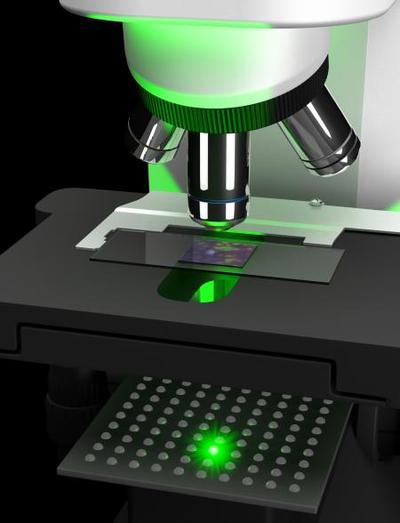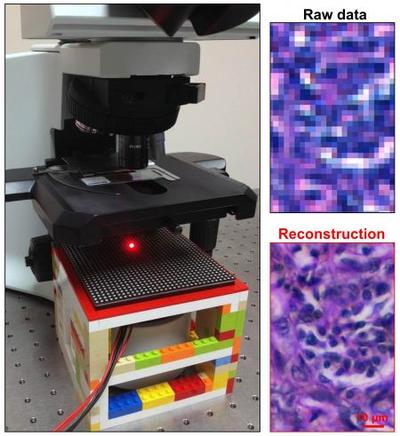Cost-effectively convert a conventional microscope into a billion-pixel imaging system
Tuesday, 06 August, 2013
Usually microscopists have to decide between high resolution and a small field of view or low resolution and a large field of view. But that need no longer be the case as California Institute of Technology (Caltech) engineers have used a computational approach to bypass the limitations of the optics and devised a method to convert a relatively inexpensive conventional microscope into a billion-pixel imaging system that significantly outperforms the best-available standard microscope.
Such a system could greatly improve the efficiency of digital pathology, in which specialists need to review large numbers of tissue samples. By making it possible to produce robust microscopes at low cost, the approach also has the potential to bring high-performance microscopy capabilities to medical clinics in developing countries.
"In my view, what we've come up with is very exciting because it changes the way we tackle high-performance microscopy," says Changhuei Yang, professor of electrical engineering, bioengineering and medical engineering at Caltech. Yang is senior author on a paper that describes the new imaging strategy, which appears in a recent online version of the journal Nature Photonics.
Until now, the physical limitations of microscope objectives - their optical lenses - have posed a challenge in terms of improving conventional microscopes. Microscope makers tackle these limitations by using ever-more complicated stacks of lens elements in microscope objectives to mitigate optical aberrations. Even with these efforts, these physical limitations have forced researchers to decide between high resolution and a small field of view on the one hand, or low resolution and a large field of view on the other. That has meant that scientists have either been able to see a lot of detail very clearly but only in a small area, or they have gotten a coarser view of a much larger area.
"We found a way to actually have the best of both worlds," says Guoan Zheng, lead author on the new paper and the initiator of this new microscopy approach from Yang's lab. "We used a computational approach to bypass the limitations of the optics. The optical performance of the objective lens is rendered almost irrelevant, as we can improve the resolution and correct for aberrations computationally."
Indeed, using the new approach, the researchers were able to improve the resolution of a conventional 2X objective lens to the level of a 20X objective lens. Therefore, the new system combines the field-of-view advantage of a 2X lens with the resolution advantage of a 20X lens. The final images produced by the new system contain 100 times more information than those produced by conventional microscope platforms. And building upon a conventional microscope, the new system costs only about $200 to implement.
"One big advantage of this new approach is the hardware compatibility," Zheng says, "You only need to add an LED array to an existing microscope. No other hardware modification is needed. The rest of the job is done by the computer."

The new system acquires about 150 low-resolution images of a sample. Each image corresponds to one LED element in the LED array. Therefore, in the various images, light coming from known different directions illuminates the sample. A novel computational approach, termed Fourier ptychographic microscopy (FPM), is then used to stitch together these low-resolution images to form the high-resolution intensity and phase information of the sample - a much more complete picture of the entire light field of the sample.
Yang explains that when we look at light from an object, we are only able to sense variations in intensity. But light varies in terms of both its intensity and its phase, which is related to the angle at which light is travelling.
"What this project has developed is a means of taking low-resolution images and managing to tease out both the intensity and the phase of the light field of the target sample," Yang says. "Using that information, you can actually correct for optical aberration issues that otherwise confound your ability to resolve objects well."

The very large field of view that the new system can image could be particularly useful for digital pathology applications, where the typical process of using a microscope to scan the entirety of a sample can take tens of minutes. Using FPM, a microscope does not need to scan over the various parts of a sample - the whole thing can be imaged all at once. Furthermore, because the system acquires a complete set of data about the light field, it can computationally correct errors - such as out-of-focus images - so samples do not need to be rescanned.
"It will take the same data and allow you to perform refocusing computationally," Yang says.
The researchers say that the new method could have wide applications not only in digital pathology but also in everything from haematology to wafer inspection to forensic photography. Zheng says the strategy could also be extended to other imaging methodologies, such as X-ray imaging and electron microscopy.
The paper is titled ‘Wide-field, high-resolution Fourier ptychographic microscopy’. Along with Yang and Zheng, Caltech graduate student Roarke Horstmeyer is also a co-author. The work was supported by a grant from the National Institutes of Health.
Revealed: the complex composition of Sydney's beach blobs
Scientists have made significant progress in understanding the composition of the mysterious...
Sensitive gas measurement with a new spectroscopy technique
'Free-form dual-comb spectroscopy' offers a faster, more flexible and more sensitive way...
The chemistry of Sydney's 'tar balls' explained
The arrival of hundreds of tar balls — dark, spherical, sticky blobs formed from weathered...




